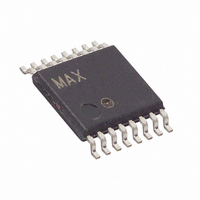MAX6602UE9A+ Maxim Integrated Products, MAX6602UE9A+ Datasheet - Page 16

MAX6602UE9A+
Manufacturer Part Number
MAX6602UE9A+
Description
IC TEMP MONITOR 5CH 16-TSSOP
Manufacturer
Maxim Integrated Products
Datasheet
1.MAX6602UE9A.pdf
(18 pages)
Specifications of MAX6602UE9A+
Function
Temp Monitoring System (Sensor)
Topology
ADC, Buffer, Register Bank
Sensor Type
External & Internal
Sensing Temperature
-40°C ~ 125°C, External Sensor
Output Type
I²C™/SMBus™
Output Alarm
Yes
Output Fan
Yes
Voltage - Supply
3 V ~ 5.5 V
Operating Temperature
-40°C ~ 125°C
Mounting Type
Surface Mount
Package / Case
16-TSSOP
Full Temp Accuracy
+/- 1 C, +/- 3 C
Digital Output - Bus Interface
Serial (2-Wire)
Digital Output - Number Of Bits
11 bit
Maximum Operating Temperature
+ 125 C
Minimum Operating Temperature
- 40 C
Lead Free Status / RoHS Status
Lead free / RoHS Compliant
Five-Channel Precision Temperature Monitor
The slave address of the MAX6602 is 9Ah or 1001 101.
Follow these guidelines to reduce the measurement
error when measuring remote temperature:
1) Place the MAX6602 as close as is practical to the
2) Do not route the DXP-DXN lines next to the deflec-
3) Route the DXP and DXN traces in parallel and in
4) Route through as few vias and crossunders as possi-
5) Use wide traces when practical. 5-mil to 10-mil
6) When the power supply is noisy, add a resistor (up
16
remote diode. In noisy environments, such as a com-
puter motherboard, this distance can be 4in to 8in
(typ). This length can be increased if the worst noise
sources are avoided. Noise sources include CRTs,
clock generators, memory buses, and PCI buses.
tion coils of a CRT. Also, do not route the traces
across fast digital signals, which can easily intro-
duce +30°C error, even with good filtering.
close proximity to each other. Each parallel pair of
traces should go to a remote diode. Route these
traces away from any higher voltage traces, such as
+12VDC. Leakage currents from PCB contamination
must be dealt with carefully since a 20MΩ leakage
path from DXP to ground causes about +1°C error.
If high-voltage traces are unavoidable, connect
guard traces to GND on either side of the DXP-DXN
traces (Figure 5).
ble to minimize copper/solder thermocouple effects.
traces are typical. Be aware of the effect of trace
resistance on temperature readings when using
long, narrow traces.
to 47Ω) in series with V
______________________________________________________________________________________
CC
.
Slave Address
PCB Layout
Use a twisted-pair cable to connect the remote sensor
for remote-sensor distances longer than 8in or in very
noisy environments. Twisted-pair cable lengths can be
between 6ft and 12ft before noise introduces excessive
errors. For longer distances, the best solution is a
shielded twisted pair like that used for audio micro-
phones. For example, Belden #8451 works well for dis-
tances up to 100ft in a noisy environment. At the
device, connect the twisted pair to DXP and DXN and
the shield to GND. Leave the shield unconnected at the
remote sensor. For very long cable runs, the cable’s
parasitic capacitance often provides noise filtering, so
the 2200pF capacitor can often be removed or reduced
in value. Cable resistance also affects remote-sensor
accuracy. For every 1Ω of series resistance, the error is
approximately +1/2°C.
Figure 5. Recommended DXP-DXN PCB Traces. The two outer
guard traces are recommended if high-voltage traces will be
near the DXN and DXP traces.
5 mils to 10 mils
5 mils to 10 mils
Twisted-Pair and Shielded Cables
GND
DXP
DXN
GND
5 mils to 10 mils
MINIMUM
5 mils to 10 mils









